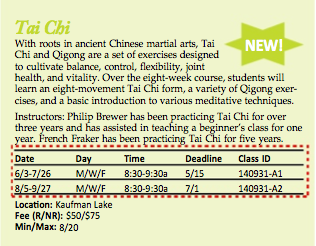Because it’s part of the taiji practice that I learned from my taiji instructor, I teach meditation as one aspect of my beginner taiji class. (I also include meditation as one aspect of the class for continuing students as well, but they know how to meditate so I don’t need to try to teach it.)
I worry that I don’t do it well, because I think of myself as a bad meditator. I’m easily distracted. Too often I spend half my time thinking about what I’ll do after I’m done meditating, and half my time thinking about stuff that happened in the past and how it went well or poorly.
But I do, now, actually meditate, however badly. That wasn’t always true. I came to meditation slowly. For a long time after starting to practice taiji I just went through the motions. I would sit while we were sitting and stand while we were standing, but not really even try to meditate. And, quite predictably, I saw few of the mental and emotional benefits of meditating.
I did, though, see some of the physical benefits—also predictably, because the physical part of sitting or standing was the part I was actually doing. I wrote about this a few years ago in a post called Physical benefits of standing meditation.
And it was then—when I saw the physical benefits of meditation—that it occurred to me that it might be useful to actually try to meditate and see if maybe the other benefits might accrue to such a practice. And they have, if only perhaps in a small way, because I’m a bad meditator.
In any case, I thought I’d go ahead and write down what I say to my meditation students, in the hope that it might be useful to others. It’s usually something like this:
To my mind, meditation is about paying attention. There are many meditation traditions which suggest different things that you might pay attention to: a repeated word or phrase such as a mantra or a prayer, or an object such as a crystal, or an image such as mandala, or your posture, or your breath.
What you choose to pay attention to is not important. What is important is simply that you’re paying attention.
In this room where we practice there are things that may distract you. The refrigerator or freezer may turn on and make noise. The people who work out front may come into the room to get their lunch. The lawnmower may go past outside the window. These things are not distractions from your meditation. Rather, they are things that are actually happening at that moment. If they capture your attention, that’s just fine. That’s what meditation is: Paying attention to what is actually happening in that moment.
What would not be fine would be to become attached to those things beyond the moment.
It would not be meditating to worry that the fridge might turn on. It would not be meditating to become annoyed at someone coming into the room to get their lunch. It would not be meditating to think that the lawn mower is going by because today is Wednesday and Wednesday is the day they mow the lawn.
Still, these things will happen. Things that capture your attention will continue to hold it beyond the moment when they are actually happening. Other thoughts will inevitably intrude. These things happen to everybody, even people who are very good at meditating.
What makes someone good at meditating is not that these things don’t happen—although they may happen less as you get better at it. What makes someone good at meditating is getting better at noticing when it has happened, and better at letting go of those thoughts and returning your attention to what is actually happening right now, right where you are.
I like this way of teaching meditation. I think it is authentic—I claim no expertise whatsoever, which is good because I’m not very good at meditation. But I think what I say is true. I think it’s what meditation is about at its deepest level.

